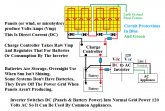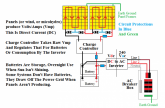Traveler004
New Member
- Joined
- Jan 6, 2020
- Messages
- 18
Hi everyone. I'm new here but have been watching will's vids for about a year and read the book. I often trip up over doing simple calculation from amps to watt hours. I have to use paper as it just isn't natural in my my head yet. One of the things i really just can't wrap my head around is load voltage.
I have a breaker box with 15amp and 20amp breakers. My 220 volt dryer is on 2x15amps double breaker which would be volia 30 amps. I can do that part, LOL.
but how did someone arrive at that. Some electrician must have said average drier uses 3.3 kwh. so 3300 watts / 220v gives me 15 amps. But its on a 30 amp breaker that's probably just elbow room. Anyhow there is that special plug for your dryer that tells you it's allot of juice.
So when deciding on a 12v or 24v DC system i'm confused because i appear to need 220v AC for my dryer. No one is talking about 220v DC systems and people are definitely hooking up big loads So what i'm i missing as I try to plan a staged conversion from grid only system to solar with automatic grid switch system?
Do i need 2 inverters? One that inverts to 120V for AC lights etc, and one that inverts to 220V for dryer. Can a 12V DC really power a 220V load? should it? what's that calculation? and since I want to put in an automatic switch I need a switch that attaches to my 30 amp breaker and from the solar controller I attach ?what?how much?
See i'm very confused. A long explanation, although appreciated might just add to my confusion as I have read allot to no avail. I'm hoping to just see an example of solar panel to clothes dryer example so that I can map it out in my head.
I have a breaker box with 15amp and 20amp breakers. My 220 volt dryer is on 2x15amps double breaker which would be volia 30 amps. I can do that part, LOL.
but how did someone arrive at that. Some electrician must have said average drier uses 3.3 kwh. so 3300 watts / 220v gives me 15 amps. But its on a 30 amp breaker that's probably just elbow room. Anyhow there is that special plug for your dryer that tells you it's allot of juice.
So when deciding on a 12v or 24v DC system i'm confused because i appear to need 220v AC for my dryer. No one is talking about 220v DC systems and people are definitely hooking up big loads So what i'm i missing as I try to plan a staged conversion from grid only system to solar with automatic grid switch system?
Do i need 2 inverters? One that inverts to 120V for AC lights etc, and one that inverts to 220V for dryer. Can a 12V DC really power a 220V load? should it? what's that calculation? and since I want to put in an automatic switch I need a switch that attaches to my 30 amp breaker and from the solar controller I attach ?what?how much?
See i'm very confused. A long explanation, although appreciated might just add to my confusion as I have read allot to no avail. I'm hoping to just see an example of solar panel to clothes dryer example so that I can map it out in my head.





